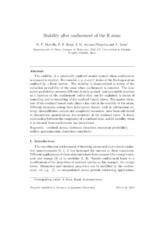Stability after confinement of the H atom
Autor
Morcillo Arencibia, Milagros Francisca
Borja, Enrique F.
Alcaraz Pelegrina, José Manuel
Sarsa, A.
Editor
ElsevierFecha
2019Materia
Confined atomsElectronic structure
Ionisation probability
Sudden approximation
Statistical complexity
METS:
Mostrar el registro METSPREMIS:
Mostrar el registro PREMISMetadatos
Mostrar el registro completo del ítemResumen
The stability of a spherically confined atomic system when confinement is removed is studied. We consider s, p, d, and f states of the Hydrogen atom confined by a finite barrier. The stability is characterized in terms of the ionization probability of the atom when confinement is removed. The ionization probability presents different sharply peaked, nonsymmetric maxima as a function of the confinement radius that can be explained in terms of tunneling and retunneling of the confined bound states. The spatial structure of the confined bound state plays a key role in the stability of the atom. Different measures arising from information theory, such as information entropy, disequilibrium indices, and complexity measures, have been calculated to characterize quantitatively the structure of the confined state. A direct relationship between the complexity of a confined state and its stability when it is released from confinement has been found.

